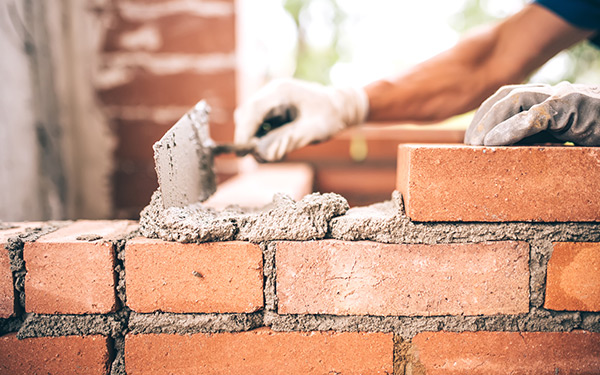Reputable Tuckpointing Services for Mending Block and Rock Surfaces
Reputable Tuckpointing Services for Mending Block and Rock Surfaces
Blog Article
Unlocking the Keys of Sustainable Stonework Construction Practices for Eco-Friendly Buildings
In the world of contemporary construction, the quest of lasting methods has actually become paramount. Among the myriad strategies to environmentally friendly structure, sustainable masonry building sticks out as a reliable and durable technique that holds a wide range of untapped capacity. From the choice of products to cutting-edge construction techniques, the tricks to accomplishing sustainability within masonry building are diverse and appealing. By exploring the benefits, materials, techniques, and future patterns of lasting masonry, a deeper understanding of exactly how these practices can form the future of eco-friendly buildings emerges.
Advantages of Sustainable Stonework Building And Construction
Embracing lasting stonework building practices not only minimizes ecological influence but likewise provides long-term economic advantages to contractors and communities. By using products like recycled blocks, blocks, and rocks, home builders can considerably lower the carbon footprint of their jobs while promoting resource performance. Furthermore, sustainable stonework construction techniques, such as appropriate insulation and thermal mass properties, can improve power effectiveness within buildings, leading to minimized operational expenses over time.
Moreover, the sturdiness and durability of masonry structures add to long-lasting financial advantages. Buildings constructed utilizing lasting masonry methods commonly require much less repair and maintenance, translating to cost savings for home builders and home owners. The long life of stonework products additionally guarantees that structures remain steady and safe, lowering the need for constant renovations or substitutes.
Eco-Friendly Masonry Materials
Using environment-friendly stonework materials is a crucial action towards improving the sustainability of construction practices and lessening ecological influence while taking full advantage of long-term economic advantages. Sustainable masonry materials are sourced, produced, and used in a way that decreases overall environmental influence. Products such as recycled bricks, reclaimed rock, and lasting cinder block are becoming progressively popular choices for eco-conscious builders. Recycled bricks, as an example, not only draw away waste from garbage dumps however additionally need less energy to produce compared to brand-new blocks. Recovered stone offers a distinct aesthetic charm while reducing the demand for brand-new quarrying. Lasting concrete obstructs incorporate recycled accumulations and might feature improved insulation residential or commercial properties, adding to energy performance in structures.
Furthermore, natural materials like adobe, rammed earth, and straw bundles supply exceptional thermal mass homes, lowering the need for heating and cooling down power. These products are typically in your area readily available, promoting local economies and minimizing transportation-related carbon discharges. By picking environment-friendly stonework materials, construction projects can dramatically minimize their ecological footprint and add to the creation of much healthier, extra sustainable developed environments.
Energy-Efficient Stonework Methods
Power efficiency plays a vital duty in boosting the sustainability of masonry building and construction methods. By carrying out energy-efficient masonry methods, builders can considerably lower the general energy intake of a building, causing reduced functional prices and a smaller environmental impact. One crucial energy-efficient stonework method is making use of thermal mass, which includes incorporating dense materials like concrete or block into the structure's framework to soak up and store warm. This assists regulate indoor temperature levels, reducing the need for mechanical heating and cooling systems.

Advancements in Sustainable Stonework
Recent innovations in lasting masonry methods have produced innovative strategies that are reshaping the building industry. One such advancement is the advancement of self-healing concrete, which utilizes germs embedded within the concrete to recover splits autonomously. This innovation not only minimizes maintenance expenses yet also improves the sturdiness of stonework structures, adding to their sustainability.
Another significant advancement is using recycled aggregates in stonework construction - masonry contractor. By integrating products such as smashed ceramic waste or recycled glass into concrete mixes, builders can decrease the ecological influence of construction projects while preserving architectural integrity. This method not only diverts waste from garbage dumps but likewise saves natural deposits, making it a key advancement in sustainable masonry construction
Additionally, the combination of electronic layout devices, such as Structure Details Modeling (BIM), is revolutionizing the means stonework frameworks are intended and constructed. BIM allows for more precise calculations, decreased material wastefulness, and improved power efficiency, ultimately leading to more lasting structure techniques. These developments collectively signify a promising future for sustainable masonry construction in the review era of green buildings.
Future Trends in Masonry Sustainability
With the innovative strides made in lasting stonework techniques, the future patterns in masonry sustainability are poised to more change the building market. One of the vital patterns shaping the future of masonry sustainability is the raised integration of technology. Improvements such as Structure Details Modeling (BIM) and digital fact simulations are being made use of to enhance masonry building procedures, leading to lowered material waste and improved power effectiveness in structures.
Moreover, the development of unique sustainable materials is established to play a considerable role in boosting the eco-friendliness of masonry building and construction. masonry contractor. Advancements like self-healing concrete, recycled aggregates, and bio-based binders white concrete are obtaining traction for their capacity to lessen environmental effect while maintaining architectural integrity

Final Thought
In conclusion, sustainable stonework building and construction techniques use countless advantages for green structures. masonry contractor. Advancements in sustainable masonry are constantly being created to better boost the ecological efficiency of buildings.
Report this page